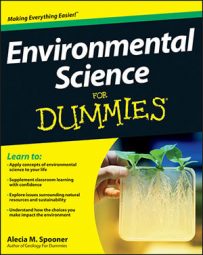Mining and burning coal for fuel is harmful to the environment; but, because coal is so abundant and cheap, many people are reluctant to give it up as a fuel source.
Coal starts as peat, or sections of partially decomposed organic matter that accumulate on the earth’s surface. Over millions of years, the peat is buried and heat and pressure transform it into increasingly pure forms of coal called lignite, sub-bituminous, bituminous, and anthracite coal.
These fossil fuels are limited or nonrenewable resources; after they serve their fuel purpose, they can’t be recycled back into a useful energy source. Their supplies are finite; when they’re gone, they’re gone. True, more coal, oil, and gas supplies may be created over time, but that won’t occur in our lifetime; fossil fuel production takes many millions of years.
Coal is found in layers of rock that have been compacted and folded into mountains. Coal resources are fairly abundant throughout the world, though like any geologic resource, they aren’t evenly distributed. The largest coal sources in the world appear in the U.S., Russia, China, India, and Australia.
The purest coal forms (bituminous and anthracite) provide the most energy, but in general, coal requires little to no refining before it can be burned as fuel. Coal’s abundance and ease of use make it an inexpensive fuel resource, particularly for developing nations that don’t yet have fancy industrial refineries.
Using coal for fuel has several downsides, including the following:
Burning coal releases toxins. Coal contains sulfur and other elements, including dangerous metals such as mercury, lead, and arsenic, that escape into the air when coal is burned. Burning coal also produces particulates that increase air pollution and health dangers.
Burning coal emits large amounts of carbon dioxide into the atmosphere. Coal is composed almost entirely of carbon, so burning coal unleashes large amounts of carbon dioxide (CO2) into the atmosphere. These emissions have been shown to increase the greenhouse effect in the atmosphere and lead to global warming.
Subsurface coal mining is dangerous. Coal is often mined in subsurface mines, which may collapse and trap miners. And the air in subsurface coal mines leads to black lung disease, where coal particles and pollutants fill the lungs and cause inflammation and respiratory illness.
Surface coal mining damages the environment. Mountaintop removal mining is used to access layers of coal buried deep within mountains. This mining technique alters the landscape and damages ecosystems.
Because coal is so abundant and relatively inexpensive, many people are reluctant to give it up as a fuel source. Luckily, ways to use coal more sustainably and minimize its environmental damage are available. Clean coal solutions include the following:
Integrated gasification combined cycle (IGCC): IGCC technology converts coal into gas, removing sulfur and metals. This gas generates electricity by fueling turbines while the side products (sulfur and metals) are concentrated and sold. IGCC plants are cleaner and more efficient than coal-burning electric plants and have the potential to capture CO2 emissions in the future.
Carbon sequestration: One of the biggest problems with burning coal is the amount of CO2 it adds to the atmosphere. Carbon sequestration includes various ways to capture and store carbon underground instead of allowing it to fill the atmosphere. Currently, some coal-burning plants store carbon in underground abandoned mines or in oil wells. Other plants pump the carbon into sedimentary rocks or below the ocean floor.

